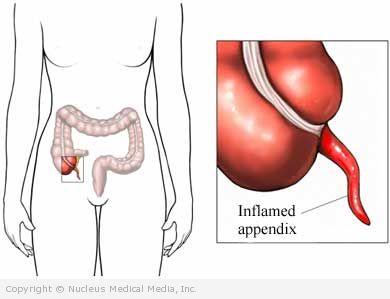Appendicitis – Definition
The appendix is a small, tube-like organ that hangs from the large intestine. Appendicitis is inflammation of the appendix. The appendix has no known function.
Appendicitis – Causes
Appendicitis usually occurs when the appendix becomes inflamed. This can be caused by something trapped in the appendix, such as:
- A piece of dried stool
- A piece of food
- Tumors
- Scar tissue
- Worms
- Barium after an exam
- Overgrowth of the lymph tissue of the appendix
The lining of the appendix continues to produce mucus. It has no place to go. Bacteria normally found in the intestines build up and make toxins in the lining of the appendix. Pressure builds and causes severe pain in the abdomen. The wall of the appendix can break open. The contents of a ruptured appendix can spill into the abdominal cavity. This causes serious redness and swelling. This is called peritonitis. It can be fatal.
Appendicitis – Risk Factors
Risk factors that can increase your chance of developing appendicitis include:
- Sex: male
- Age: teen years
- Family members who have had appendicitis
Appendicitis – Symptoms
Symptoms usually happen quickly. Pain usually increases during a 6-12 hour period. Patients may have some or all of the following symptoms:
- Pain
- Starts as discomfort around the belly button
- Usually moves to the right side of the abdomen over several hours
- May be in a different location if the appendix is not in the usual place
- Increases as redness and swelling in the appendix builds
- Worsens with sneezing, coughing, and deep breathing
- May increase with movement
- Loss of appetite
- Nausea
- Vomiting
- Swelling of the abdomen
- Abdomen feels hard and is sensitive to touch
- Constipation
- Mild diarrhea
- Slight fever
If the appendix ruptures, symptoms include:
- Pain becoming stronger and spreading across the abdomen
- Increasing fever
Note: Symptoms may be different in infants, children, pregnant women, and the elderly.
Appendicitis – Diagnosis
Get medical help right away if you have severe pain in the abdomen. Appendicitis can be hard to diagnose. Symptoms vary and can be similar to symptoms of other diseases.
The doctor will ask about your symptoms and medical history. A physical exam will be done, including:
- A careful examination of the abdomen
- A rectal exam
Other tests to determine the cause of your pain may include:
- Blood tests
- Urine tests
- CT scan or ultrasound
- Laparoscopy
Appendicitis – Treatment
Appendicitis is treated by surgically removing the appendix as soon as possible. Sometimes the diagnosis is not certain. The doctor will carefully monitor your condition for 6-12 hours before operating. You will also be given antibiotics to fight infection.
Follow your doctor’s instructions if you are diagnosed with appendicitis.
Appendicitis – Prevention
There are no guidelines to prevent appendicitis. It starts quickly and the cause is usually unknown. Get medical care right away for severe abdominal pain. It will decrease the risk of rupture.

